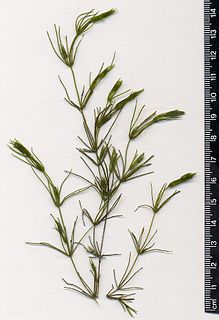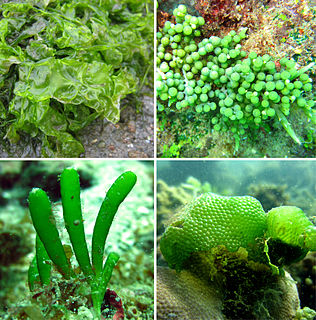
Chlorophyta or Prasinophyta is a taxon of green algae informally called chlorophytes. The name is used in two very different senses, so care is needed to determine the use by a particular author. In older classification systems, it refers to a highly paraphyletic group of all the green algae within the green plants (Viridiplantae) and thus includes about 7,000 species of mostly aquatic photosynthetic eukaryotic organisms. In newer classifications, it refers to the sister of the streptophytes/charophytes. The clade Streptophyta consists of the Charophyta in which the Embryophyta emerged. In this sense the Chlorophyta includes only about 4,300 species. About 90% of all known species live in freshwater. Like the land plants, green algae contain chlorophyll a and chlorophyll b and store food as starch in their plastids.

The green algae are a large, informal grouping of algae consisting of the Chlorophyta and Charophyta/Streptophyta, which are now placed in separate divisions, together with the more basal Mesostigmatophyceae, Chlorokybophyceae and Spirotaenia.

The National Democratic Party is a political party in Suriname. It was founded on 4 July 1987 by Surinamese leader Dési Bouterse, and was one of the first parties in the country to have a stable base of support across different ethnic groups. In the 2015 general election the party scored 45.56% of the vote and 26 of 51 seats in parliament.

The Charophyta or charophytes is a group of freshwater green algae, sometimes treated as a division, but also as a superdivision, or an unranked clade. The terrestrial plants, the Embryophyta most likely emerged within Charophyta, possibly from terrestrial unicellular charophytes, with the class Zygnematophyceae as a sister group.

Viridiplantae are a clade of eukaryotic organisms that comprise approximately 450,000–500,000 species and play important roles in both terrestrial and aquatic ecosystems. They are made up of the green algae, which are primarily aquatic, and the land plants (embryophytes), which emerged from within them. Green algae traditionally excludes the land plants, rendering them a paraphyletic group. Since the realization that the embryophytes emerged from within the green algae, some authors are starting to include them. They have cells with cellulose in their cell walls, and primary chloroplasts derived from endosymbiosis with cyanobacteria that contain chlorophylls a and b and lack phycobilins.

The arrondissement of Montbéliard is an arrondissement of France in the Doubs department in the Bourgogne-Franche-Comté region. It has 168 communes. Its population is 176,425 (2016), and its area is 1,255.7 km2 (484.8 sq mi).

Charophyceae is a class of charophyte green algae, and consists of the single order Charales, commonly known as "stoneworts" and "brittleworts". It is a basal Phragmoplastophyta clade as sister of another unnamed clade which contains the Embryophytes. Charophyceae are a class within the Streptophyta. Current consensus treats Charophyceae as a class under division Charophyta, with Chlorophyta remaining a distinct division. In 2018, the first nuclear genome sequence from a species belonging to the most basal branch within the Phragmoplastophyta, the Charophyceae, has been published: that of Chara braunii

The Archaeplastida are a major group of eukaryotes, comprising the red algae (Rhodophyta), the green algae, and the land plants, and some smaller groups such as the glaucophytes. All of the lineages of Archaeplastida have become photoautotrophic, except for the lineage Rhodelphidia, sister to the Rhodophyta, which is still a non-photosynthetic predatorial (eukaryotrophic) flagellate. The Archaeplastida have chloroplasts that are surrounded by two membranes, suggesting that they were acquired directly through a single endosymbiosis event by feeding on a cyanobacterium. All other groups which have chloroplasts, besides the amoeboid Paulinella chromatophora, have chloroplasts surrounded by three or four membranes, suggesting they were acquired secondarily from red or green algae. Unlike red and green algae, glaucophytes have never been involved in secondary endosymbiosis events.

The Prasinophytes or chlorophyta are a class of unicellular green algae. Prasinophytes mainly include marine planktonic species, as well as some freshwater representatives. The prasinophytes are morphologically diverse, including flagellates with one to eight flagella and non-motile (coccoid) unicells. The cells of many species are covered with organic body scales; others are naked. Well studied genera include Ostreococcus, considered to be the smallest free-living eukaryote, and Micromonas, both of which are found in marine waters worldwide. Prasinophytes have simple cellular structures, containing a single chloroplast and a single mitochondrion. The genomes are relatively small compared to other eukaryotes.
Microchannel in microtechnology is a channel with a hydraulic diameter below 1 mm. Microchannels are used in fluid control and heat transfer. The concept of the microchannel was proposed for the first time by researchers Tuckerman and Pease of Stanford Electronics Laboratories in 1981. They suggested an effective method for designing microchannels in the laminar and fully developed flow.
Doris Aileen Bartholomew is an American linguist whose published research specialises in the lexicography, historical and descriptive linguistics for indigenous languages in Mexico, in particular for Oto-Manguean languages. Bartholomew's extensive publications on Mesoamerican languages span five decades of active research. She has also published extensively on Zapotecan languages and the Otomi language. She has been editor-in-chief and publications director for the Instituto Lingüístico de Verano (ILV), the affiliate body incorporated in Mexico for SIL International.

Pretaapnarian Shawh Radhecheran Radhakishun was a Surinamese politician. He was Prime Minister of Suriname from July 1986 to April 1987, and Vice President of Suriname from September 1996 to August 2000.
Willem "Wim" Alfred Udenhout was the military-installed Prime Minister of Suriname from February 1984 to July 1986. He had previously been a teacher and, for a time, a Black Power activist. As an academic he had a PhD in English literature from Leiden University. He later served as an ambassador to the United States. He did not favor investigating the military's murder of civilians or of Maroon people. He is most recently the Chairman of the Suriname Conservation Foundation.

Star Dust is an album of phonograph records by Bing Crosby released in 1940 featuring songs that are sung sentimentally, being based upon the 1927 popular song "Star Dust". This album featured his 1939 Decca recording of the song, not the 1931 recording he made for Brunswick.

The Phragmoplastophyta or Streptophytina are a proposed sister clade of the Klebsormidiaceae, with which they form the Streptophyte/Charophyte clade. The Phragmoplastophyta consist of the Charophycaea and another unnamed clade which contains the Coleochaetophyceae, Zygnematophyceae, Mesotaeniaceae, and Embryophytes. It is an important step in the emergence of land plants within the green algae. It is equivalent to the ZCC clade/grade, cladistically granting the Embryophyta.
The Tetraphytina or 'core Chlorophyta' are a proposed derived Chlorophyta clade. The basal Tetraphytina clades are the Pedinophyceae and the Chlorophytina.

The Chlorophytina are a proposed basal Tetraphytina clade. It is currently seen as sister of the Pedinomonadaceae.
Peptoniphilus timonensis is a Gram-positive and anaerobic bacterium from the genus of Peptoniphilus which has been isolated from human feces from Dielmo in Senegal.












